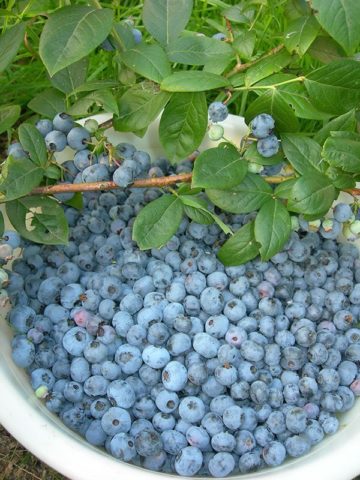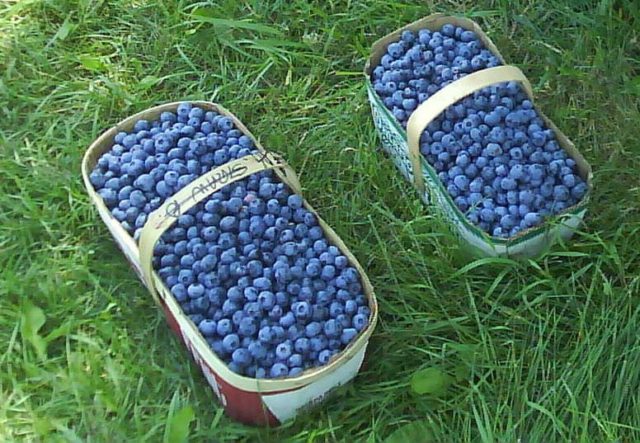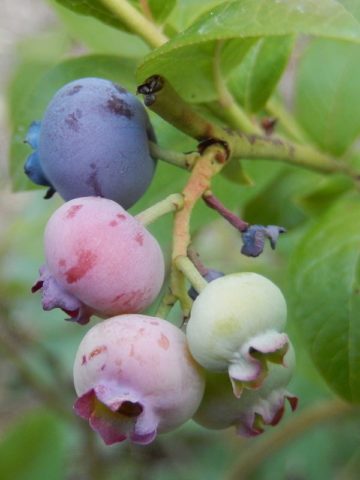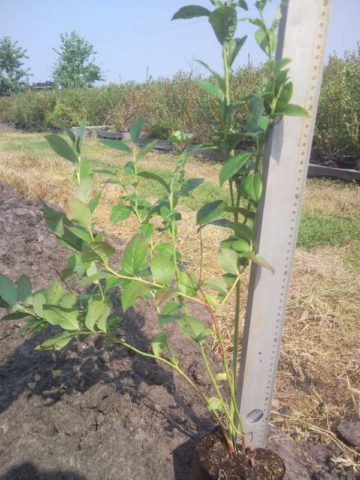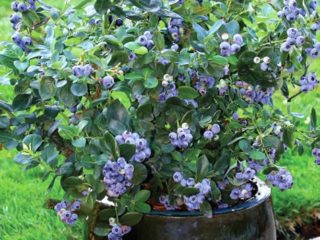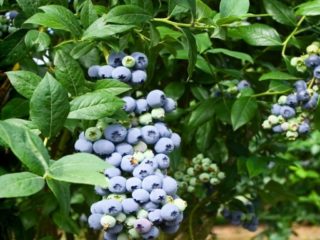Content
A description of the variety and reviews of Elizabeth's blueberries will be very useful for the farmer. But the history of the emergence of this variety is truly unique. At the origins of the creation of the hybrid was a passionate woman, the daughter of an American farmer, Elizabeth Coleman White. She fanatically searched the wild forests for specimens with the largest berries. The result of her work was the appearance of the first blueberry variety, which propagated by cuttings - Rubel. Further hybridization was carried out by Frederick Vernon Covill, and in 1966 the first varietal specimens of Elizabeth blueberries went on sale. This variety of American selection is known all over the world, but it is not included in the State Register of the Russian Federation.
Description of Elizabeth blueberry
Elisabeth tall blueberry is a medium-late ripening variety. The bush is sprawling, erect, up to 1.6-1.7 m high. The shoots are painted in a reddish tint, the crown is thickened. The leaves are small, dense, dark green, with a pronounced bluish bloom. By the fall they turn slightly red. The flowers are white, with a touch of pink, bell-shaped, 1-1.5 cm in length. The root system is fibrous, slightly branched, without a large number of small hairs.
Features of fruiting
Elizabeth is a self-pollinating variety. To get more tasty, juicy and large berries, it is recommended to plant next to other varieties with the same flowering period: Bluecrop, Nelson, Darrow, Jersey. The expected time for the appearance of the first ripe berries on the bush is the beginning of August.
The berries are large, 20-22 mm in diameter, sweet, aromatic. Easily removed from the branch. The skin is dense, blue, with a slight scar. Unripe fruits are green with a milky reddish tint. The brushes are small, loose.
In terms of taste, it is considered one of the best varieties in the world. The taste is soft, rich, with a grape aftertaste. Fruiting is good, about 4-6 kg per bush, with an extended ripening period up to 2 weeks. The transportability of the fruits is excellent. The berries are suitable for personal consumption and sale in supermarkets. Elizabeth blueberries are used to make flavorful sauces, jam jams.
Advantages and disadvantages
Large farmers distinguish many advantages from the Elizabeth blueberry variety:
- good frost resistance of shoots;
- pronounced dessert taste of fruits;
- exactingness to the composition of the soil;
- resistance of the variety to diseases and pests;
- decent yield and transportability.
The photo shows the correct container for transporting the Elizabeth blueberry:
The disadvantages include:
- inability of fruits to ripen in a sudden cold autumn;
- exactingness to care, due to strong lateral growth;
- dependence on weather changes during flowering.
Breeding features
Propagated by green cuttings. An adult plant forms a large number of red shoots, which grow stiff with age, branch strongly to the side and inward. The seed method of reproduction is allowed, but such bushes will give fruits for 7-8 years of growth.
Vegetative propagation methods are considered the most optimal:
- Cutting, through selection and rooting in pots of the apical part of last year's shoot. The finished seedlings are transferred to a permanent place in the second year.
- Reproduction by layering from the mother plant through the rooting of the shoot into the ground.
- Dividing an adult bush in half.
Planting and caring for Elizabeth blueberries
Compliance with the timing and technology of planting will be the key to a bountiful harvest in the future. In the wild, blueberries grow in marshlands. The gardener's task is to create conditions as close as possible to natural ones.
Recommended timing
It is customary to plant blueberries in autumn and spring. Spring planting before the buds swell is considered preferable, because over the summer the seedlings have time to take root and get stronger.
Site selection and soil preparation
Blueberries absolutely do not tolerate sandy and clayey soils. It bears fruit well on loose soils with a moderate peat content, with an acid reaction (pH 3.5), and a lot of moisture. For planting blueberries, a sunny area is chosen so that the bush does not fall from the shadow of the trees.
Standard pits for planting strawberries in a private farm are prepared in advance. A substrate based on high-moor peat is laid at the bottom of the hole. The substrate is prepared according to the proportion of 1 part of peat to 3 parts of river sand. The soil is fertilized with complex mineral fertilizers Master Valagro, Fertis NPK 12-8-16 + ME, BIOGrand "AGRO-X".
Landing algorithm
As a planting material, choose healthy, 2-3-year-old seedlings with a closed root system in pots or bags. Before planting, the root system is soaked so as not to injure when removed from the pot.
The standard blueberry planting scheme is as follows:
- pit size 50x50 cm;
- depth 40-50 cm;
- row spacing 2.5-3 m.
The blueberry planting algorithm is extremely simple:
- Drainage from rubble, pebbles, gravel is laid at the bottom of the pit.
- An earthen lump with a seedling is carefully lowered into the hole.
- The root collar is deepened by 5 cm, the roots are straightened.
- Fall asleep with prepared substrate and compact.
- The trunk circle is mulched with a 5-centimeter layer of sawdust.
With proper care, the first crop will appear 2-3 years after planting.
Growing and care
The quantity and quality of the harvested crop directly depends on the care of mature bushes.
Watering schedule
Blueberries of the Cultivar Elizabeth do not tolerate prolonged dry periods. At this time, abundant irrigation of the bushes is carried out 3-4 times a week after sunset. At the same time, prolonged stagnation of water leads to decay of the root system and the death of the bush.
During the period of intensive ripening of the crop, the bushes are watered 2 times a day, in the morning and in the evening. The recommended watering frequency is 2-3 times a week. Water consumption for one adult blueberry bush is 10 liters per watering.
Feeding schedule
If the planting was carried out correctly, in compliance with all requirements, the first feeding is carried out at the age of 1 year. 5-7 kg of compost or peat and a mineral substrate are introduced under the bush. The recommended composition of the mixture for 1 adult bush:
- 1 tsp superphosphate;
- 1 tsp urea;
- 1 tsp potassium sulfate.
The finished powder is diluted in 10 liters of water and the plant is poured.
For older bushes, the concentration of mineral fertilizers and the amount of peat are increased.
Soil acidity
The acidity level of the soil is important when growing Elizabeth blueberries. Determine the percentage of alkalization of the soil using special test strips (pH tester).
Soil acidification is carried out with a special solution: for 1 bucket of water 2 tsp. citric or malic acid or 100 ml of vinegar 9%.Additionally, 3-5 kg of sour peat is introduced under the bush. Rapid acidification methods should be used with extreme caution, as they lead to the leaching of trace elements from the soil.
Pruning
Elisabeth blueberries are sanitized annually, in late fall or early spring. Broken, diseased, barren branches are removed. The first serious pruning for crown thinning is carried out 4-5 years after planting.
Preparing for winter
The reddish tint of Elizabeth blueberry shoots indicates a high level of frost resistance. The bushes winter quietly without shelter at a temperature of -35 ° C.
For the winter, the root system is covered with a new layer of dry mulch from sawdust, old needles, hay. The fallen snow is scooped up to the bush.
Pests and diseases
Blueberries of the Elisabeth cultivar are highly resistant to all known pests and diseases. Timely sanitary thinning of the crown minimizes the risk of contracting fungal diseases.
The most common blueberry diseases include berry mummification, anthracnose, gray rot, white leaf spot. The methods of dealing with all fungal infections are identical: regular thinning of the crown, spraying the bush with a fungicide, burning the affected parts of the plant.
Among the pests, the fruit moth, kidney mite, leaf gall midge, black aphid, flower beetle weevil, comma-shaped scale insect are especially dangerous. Insects are destroyed with chemicals, the affected branches and berries are removed.
Conclusion
According to the description of the Elizabeth blueberry variety, it is clear that this is an unpretentious fruitful variety, with tasty and aromatic berries. The basis of Elizabeth's blueberry care is the regular cleaning of the crown and acidification of the soil around the bush. With timely care, the bush will begin to bear fruit in 2-3 years.
